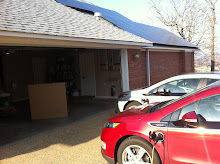Through Sept
2012, Wind was 3.3% of electricity generation, Nat Gas 31.4%, Coal 36.5%,
Nuclear 18.8%, Hydro 7%. Wind generation grew 17.7% since the first 9 months of
2011 & 10-yr CAGR is 28.3%; NG grew 26%.
Saturday, November 24, 2012
Wednesday, November 7, 2012
Plains & Eastern Clean Line a Partial Answer to Climate Change Jobs for Arkansans
All,
This is a major step to
end the burning of coal in Arkansas, provide jobs, and enable clean energy
development throughout the region: http://us2.campaign-archive1.com/?u=a4f79d8e295e7436abdc47a95&id=fe6b8714a1&e=a3aba0cd9a
Without an upgraded
smart grid, 1 trainload of 100+ cars of Powder River Basin coal per day will
continue burning at each of the Flint Creek and the White Bluff coal-fired
electric generating plants. This Clean Line Transmission Project, if done with
proper environmental supervision, can transform our economy from dependence on
coal to renewable energy. Both windpower and solar (distributed and
utility-scale) would benefit because when the wind isn't blowing solar PV and
thermal solar are excellent ways to meet peak power requirements. This can
support sustainable development and jobs in Arkansas and throughout the
southern U.S. Arkansas' abundant biomass and geothermal resources would be
excellent as reserve power. We have not even scratched the surface in potential
demand response systems, using voluntary curtailments in exchange for monetary
savings as practiced in the NE and SW. We have among the least efficient
building stocks in the country, meaning that efficiency alone would save more money
and represent more job creation in the beaten-down construction industry than
anyone can imagine. Natural Gas from Arkansas can serve a temporary
backup role to ensure cheaper and cleaner peak power than coal. Politically,
the in-state NG industry can help us counterbalance the out-of-state influences
of the coal industry.
The use of windpower is
already lowering electric bills in the SWEPCO service area (will lower bills by
0.1 cents per kWH https://www.swepco.com/info/projects/WindPowerPurchase/).
If the Flint Creek Plant gets the EPA-required retrofits to stop polluting our
air with mercury, NOx, SOx, and soot, the costs to SWEPCO customers will be an
average increase of 3.85% and 3.4% for customers of the cooperatives https://www.swepco.com/info/projects/FlintCreekPlant/.
The retrofit would make carbon emissions even worse by taking a plant designed
to be minimally efficient (less than 29% thermal efficiency by design) and
making it less efficient than the original design.
Carbon emissions are the
main cause of Climate Change- which contribute to our droughts in the South Central
region and to hurricanes like Sandy and Irene and Katrina (http://thinkprogress.org/climate/2012/11/06/1144431/study-were-headed-to-11f-warming-and-even-7f-requires-nearly-quadrupling-the-current-rate-of-decarbonisation/
and http://thinkprogress.org/climate/2012/11/06/1146281/the-insurance-industry-is-finally-waking-up-and-smelling-the-climate-chaos-coffee/
and http://thinkprogress.org/climate/2012/03/26/451605/nature-strong-evidence-manmade-unprecedented-heat-rainfall-extremes-causing-intense-human-suffering/
and http://thinkprogress.org/climate/2009/09/08/204561/climate-change-adaptation-impacts-iied/
and http://thinkprogress.org/climate/2012/10/14/1009121/science-of-global-warming-impacts-guide/
and ). “Eric Pooley, senior vice president of the
Environmental Defense Fund (and former deputy editor of Bloomberg
Businessweek), offers a baseball analogy: ‘We can’t say that steroids
caused any one home run by Barry Bonds, but steroids sure helped him hit more
and hit them farther. Now we have weather on steroids.’” http://thinkprogress.org/climate/2012/11/01/1122241/bloomberg-businessweek-its-global-warming-stupid/ “The answer to
the oft-asked question of whether an event is caused by climate change is that
it is the wrong question. All weather events are affected by climate change
because the environment in which they occur is warmer and moister than it used
to be….” http://thinkprogress.org/climate/2012/03/25/451347/must-read-trenberth-how-to-relate-climate-extremes-to-climate-change/.
Meanwhile,
the Cleanline Project addresses directly an increase in availability of
renewable power from regional wind https://www.swepco.com/global/utilities/lib/docs/info/projects/WindPowerPurchase/swepco-SPP-MajesticWind.pdf and
http://thinkprogress.org/climate/2011/10/31/356735/revkin-sheen-report-debunks-anti-deployment-climate-strategy/. The Climate Progress links include
meticulous links to peer-reviewed science supporting the assertions.
Please support the
Cleanline Project and attend the meeting at the U of A Extension Office in Van
Buren (near I-40 exit 5) on Tuesday, 13Nov12 at 9 am if you can. This is our
opportunity to answer SWEPCO and the AECC in a practical response.
We can end the death grip
of coal burning!
All the Best,
Terry
Friday, August 24, 2012
Through June 2012, Wind was 3.8% of electricity generation, Nat Gas 30.4%, Coal 35.4%, Nuclear 19.5%, Hydro 7.9%. Wind generation grew 16.3% since the first 6 months of 2011; NG grew 34%.
Source: http://www.eia.gov/electricity/monthly/ modified to combine Table 1-1 w/ 1-1a
Friday, August 10, 2012
For fans of The Hunger Games
For fans of The Hunger
Games: Suzanne Collins is a modern-day St John of Patmos, illustrating her
vision of the aftermath of the coming devastation due to Climate Change. Don’t
believe me? From page 18, “Just as the town clock strikes two, the mayor steps
up to the podium and begins to read. It’s the same story every year. He tells
the history of Panem, the country that rose up out of the ashes of a place that
was once called North America. He lists the disasters, the droughts, the
storms, the fires, the encroaching seas that swallowed up so much of the land,
the brutal war for what little sustenance remained.” This is a clear
description of the mechanism of climate change ending in our worst fears.
Subscribe to:
Posts (Atom)


